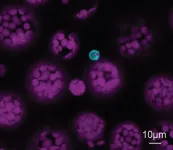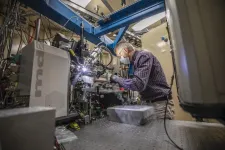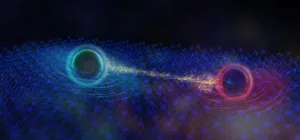(Press-News.org) WASHINGTON - Computer-based artificial intelligence can function more like human intelligence when programmed to use a much faster technique for learning new objects, say two neuroscientists who designed such a model that was designed to mirror human visual learning.
In the journal Frontiers in Computational Neuroscience, Maximilian Riesenhuber, PhD, professor of neuroscience, at Georgetown University Medical Center, and Joshua Rule, PhD, a postdoctoral scholar at UC Berkeley, explain how the new approach vastly improves the ability of AI software to quickly learn new visual concepts.
"Our model provides a biologically plausible way for artificial neural networks to learn new visual concepts from a small number of examples," says Riesenhuber. "We can get computers to learn much better from few examples by leveraging prior learning in a way that we think mirrors what the brain is doing."
Humans can quickly and accurately learn new visual concepts from sparse data ¬- sometimes just a single example. Even three- to four-month-old babies can easily learn to recognize zebras and distinguish them from cats, horses, and giraffes. But computers typically need to "see" many examples of the same object to know what it is, Riesenhuber explains.
The big change needed was in designing software to identify relationships between entire visual categories, instead of trying the more standard approach of identifying an object using only low-level and intermediate information, such as shape and color, Riesenhuber says.
"The computational power of the brain's hierarchy lies in the potential to simplify learning by leveraging previously learned representations from a databank, as it were, full of concepts about objects," he says.
Riesenhuber and Rule found that artificial neural networks, which represent objects in terms of previously learned concepts, learned new visual concepts significantly faster.
Rule explains, "Rather than learn high-level concepts in terms of low-level visual features, our approach explains them in terms of other high-level concepts. It is like saying that a platypus looks a bit like a duck, a beaver, and a sea otter."
The brain architecture underlying human visual concept learning builds on the neural networks involved in object recognition. The anterior temporal lobe of the brain is thought to contain "abstract" concept representations that go beyond shape. These complex neural hierarchies for visual recognition allow humans to learn new tasks and, crucially, leverage prior learning.
"By reusing these concepts, you can more easily learn new concepts, new meaning, such as the fact that a zebra is simply a horse of a different stripe," Riesenhuber says.
Despite advances in AI, the human visual system is still the gold standard in terms of ability to generalize from few examples, robustly deal with image variations, and comprehend scenes, the scientists say.
"Our findings not only suggest techniques that could help computers learn more quickly and efficiently, they can also lead to improved neuroscience experiments aimed at understanding how people learn so quickly, which is not yet well understood," Riesenhuber concludes.
INFORMATION:
This work was supported in part by Lawrence Livermore National Laboratory and by the National Science Foundation (1026934 and 1232530) Graduate Research Fellowship Grants.
About Georgetown University Medical Center
As a top academic health and science center, Georgetown University Medical Center provides, in a synergistic fashion, excellence in education -- training physicians, nurses and other health care professionals, as well as biomedical scientists -- and cutting-edge interdisciplinary research collaboration, enhancing our basic science and translational biomedical research capacity in order to improve human health. Patient care and clinical research is conducted with our clinical partner, MedStar Health. GUMC's mission is carried out with a strong emphasis on social justice and a dedication to the Catholic, Jesuit principle of cura personalis -- or "care of the whole person." GUMC comprises the School of Medicine, the School of Nursing & Health Studies, Biomedical Graduate Education, and Georgetown Lombardi Comprehensive Cancer Center. Designated by the Carnegie Foundation as a "very high research activity university," Georgetown is home to a Clinical and Translational Science Award from the National Institutes of Health, and a Comprehensive Cancer Center designation from the National Cancer Institute.
Connect with GUMC on Facebook (Facebook.com/GUMCUpdate) and on Twitter (@gumedcenter).
The Korea Institute of Science and Technology (KIST) has announced that the research team led by Dr. Kim Kyoung-Whan at the Center for Spintronics has proposed a new principle about spin memory devices, which are next-generation memory devices. This breakthrough presents new applicability that is different from the existing paradigm.
Conventional memory devices are classified into volatile memories, such as RAM, that can read and write data quickly, and non-volatile memories, such as hard-disk, on which data are maintained even when the power is off. In recent years, related academic and industrial fields have been combining their advantages to accelerate the development of next-generation memory that is fast and capable of maintaining data even when the power is off.
A spin memory ...
The leaf vasculature of plants plays a key role in transporting solutes from where they are made - for example from the plant cells driving photosynthesis - to where they are stored or used. Sugars and amino acids are transported from the leaves to the roots and the seeds via the conductive pathways of the phloem.
Phloem is the part of the tissue in vascular plants that comprises the sieve elements - where actual translocation takes place - and the companion cells as well as the phloem parenchyma cells. The leaf veins consist of at least seven distinct cell types, with specific roles in transport, metabolism and signalling.
Little is known about ...
A team of HIV researchers, cellular biologists, and biophysicists who banded together to support COVID-19 science determined the atomic structure of a coronavirus protein thought to help the pathogen evade and dampen response from human immune cells. The structural map - which is now published in the journal PNAS, but has been open-access for the scientific community since August - has laid the groundwork for new antiviral treatments tailored specifically to SARS-CoV-2, and enabled further investigations into how the newly emerged virus ravages the human body.
"Using X-ray crystallography, we built an ...
A new study published in the American Journal of Preventive Medicine found a 25% increase in food insufficiency during the COVID-19 pandemic. Food insufficiency, the most extreme form of food insecurity, occurs when families do not have enough food to eat. Among the nationally representative sample of 63,674 adults in the US, Black and Latino Americans had over twice the risk of food insufficiency compared to White Americans.
"People of color are disproportionately affected by both food insufficiency and COVID-19," said Jason Nagata, MD, MSc, assistant professor of pediatrics at the University of California, San Francisco and lead author on the study. "Many of these individuals have experienced job loss and higher rates of poverty during the ...
During April 2020, while the UK was in full lockdown, there was a drop of more than a third in the number of people seeking help for mental illness or self-harm according to research involving 14 million people registered at general practices across the four nations of the UK which was published today in The Lancet Public Health*.
The research, 'Effects of the COVID-19 pandemic on primary care-recorded mental illness and self-harm episodes in the UK: a population-based cohort study', was conducted by the National Institute for Health Research Greater Manchester Patient Safety Translational Research Centre (NIHR GM PSTRC). The Centre is a partnership between The University of Manchester and Salford Royal NHS Foundation ...
In a surprising discovery, Princeton physicists have observed an unexpected quantum behavior in an insulator made from a material called tungsten ditelluride. This phenomenon, known as quantum oscillation, is typically observed in metals rather than insulators, and its discovery offers new insights into our understanding of the quantum world. The findings also hint at the existence of an entirely new type of quantum particle.
The discovery challenges a long-held distinction between metals and insulators, because in the established quantum theory of materials, insulators were not thought to be able to ...
Reston, Virginia--Physicians who follow artificial intelligence (AI) advice may be considered less liable for medical malpractice than is commonly thought, according to a new study of potential jury candidates in the U.S. Published in the January issue of The Journal of Nuclear Medicine (JNM). The study provides the first data related to physicians' potential liability for using AI in personalized medicine, which can often deviate from standard care.
"New AI tools can assist physicians in treatment recommendations and diagnostics, including the interpretation of medical images," remarked Kevin Tobia, JD, PhD, ...
TORONTO, ON - New research led by researchers at the University of Toronto (U of T) and Northwestern University employs machine learning to craft the best building blocks in the assembly of framework materials for use in a targeted application.
The findings, published today in Nature Machine Intelligence, demonstrated that the use of artificial intelligence (AI) approaches can help in proposing novel materials for diverse applications. One example is the separation of carbon dioxide from industrial combustion processes. AI approaches promise the acceleration of the design cycle for materials.
With the objective of improving the separation of chemicals in industrial processes, the team of researchers - including collaborators from ...
'This effort truly represents a "moonshot" in COVID-19 research'
Scientists identify target to treat COVID pneumonia and reduce severity
Clinical trials with new experimental drug to begin early in 2021
Goal is to develop treatments that make COVID-19 no worse than a common cold
First comparison between immune mechanisms driving COVID-19 pneumonia with other pneumonias
CHICAGO --- Bacteria or viruses like influenza that cause pneumonia can spread across large regions of the lung over the course of hours. In the modern intensive care unit, these bacteria or viruses are usually controlled either by antibiotics or by the body's immune system within ...
How are networks of neurons connected to make functional circuits? This has been a long standing question in neuroscience. To answer this fundamental question, researchers from Boston Children's Hospital and Harvard Medical School developed a new way to study these circuits and in the process learn more about the connections between them.
"Neural networks are extensive, but the connections between them are really small," says Wei-Chung Allen Lee, PhD, of the F.M. Kirby Neurobiology Center at Boston Children's and Harvard Medical School. "So, we have had to develop techniques to see them in extremely high-resolution over really large areas and volumes." ...



